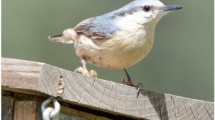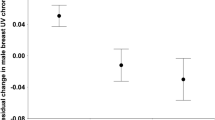Abstract
The Florida Scrub-Jay is a monogamous cooperative breeder in which both males and females display extensive structurally based blue plumage. Juveniles of this species exhibit blue tail and wing feathers that they begin growing as nestlings, and some of these feathers are retained throughout their first year. Although the birds appear to be sexually monochromatic, we assessed whether cryptic dichromatism exists in both the magnitude and pattern of coloration in tail feathers of juvenile Florida Scrub-Jays. We then determined whether variation in plumage coloration is associated with nutritional condition during molt. Tails of juvenile male Florida Scrub-Jays exhibit a greater proportion of UV reflectance than those of females. Mass at age 11 days and ptilochronology of the juvenile tail feathers were used as measures of individual nutritional condition during feather growth, and the latter was found to be positively associated with UV chroma. These data demonstrate that Florida Scrub-Jays are sexually dichromatic and suggest that variation in plumage color may be condition dependent, although we cannot rule out alternative explanations. Juvenile plumage coloration, therefore, has the potential to function as a signal of individual quality in both males and females.


Similar content being viewed by others
References
Andersson M (1994) Sexual selection. Princeton University Press, Princeton
Bancroft GT, Woolfenden GE (1982) The molt of scrub jays and blue jays in Florida. Ornithological monograph 29. American Ornithologist’s Union, Washington, DC
Eaton MD (2005) Human vision fails to distinguish widespread sexual dichromatism among sexually “monochromatic” birds. Proc Natl Acad Sci USA 102:10942–10946
Fisher RA (1958) The genetical theory of natural selection, 2nd edn. Dover, New York
Griffiths R, Double MC, Orr K, Dawson RJG (1998) A DNA test to sex most birds. Mol Ecol 7:1071–1075
Grubb TC (1989) Ptilochronology: feather growth bars as indicators of nutritional status. Auk 106:314–320
Grubb TC, Woolfenden GE, Fitzpatrick JW (1998) Factors affecting nutritional condition of fledgling Florida Scrub-Jays: a ptilochronology approach. Condor 100:753–756
Hamilton WD, Zuk M (1982) Heritable true fitness and bright birds: a role for parasites? Science 218:384–386
Hoelzer G (1989) The good parent process of sexual selection. Anim Behav 38:1067–1078
Hill G (1991) Plumage coloration is a sexually selected indicator of male quality. Nature 350:337–339
Hill GE, McGraw KJ (2006) Preface. In: Hill GE, McGraw KJ (eds) Bird coloration. Mechanisms and measurements, vol 1. Harvard University Press, Cambridge, pp 7–9
Hill GE, Montgomerie R (1994) Plumage colour signals nutritional condition in the house finch. Proc Roy Soc Lond B 25:47–52
Jacot A, Kempenaers B (2007) Effects of nestling condition on UV plumage traits in blue tits: an experimental approach. Behav Ecol 18:34–40
Jenkins KD, Hawley DM, Farabaugh CS, Cristol DA (2001) Ptilochronology reveals differences in condition of captive White-throated Sparrows. Condor 103:579–586
Johnsen A, Delhey K, Andersson S, Kempenaers B (2003) Plumage colour in nestling blue tits: sexual dichromatism, condition dependence and genetic effects. Proc Roy Soc Lond B 270:1263–1270
Kilner RM (1999) Family conflicts and the evolution of nestling mouth colour. Behav 126:779–804
Kilner RM (2006) Function and evolution of color in young birds. In: Hill GE, McGraw KJ (eds) Bird coloration: function and evolution, vol 2. Harvard University Press, Cambridge, pp 201–232
Kodric-Brown A, Brown J (1984) Truth in advertising: the kind of traits favored by sexual selection. Am Nat 124:309–323
Krebs EA, Putland DA (2004) Chic chicks: the evolution of chick ornamentation in rails. Behav Ecol 15:946–591
Lyon BE, Eadie JM, Hamilton LD (1994) Parental choice selects for ornamental plumage in American Coot chicks. Nature 37:240–243
Mennill DJ, Doucet SM, Montgomerie R, Ratcliffe LM (2003) Achromatic color variation in black-capped chickadees Poecile atricapilla: black and white signals of sex and rank. Behav Ecol Sociobiol 53:350–357
Michener H, Michener JR (1938) Bars in flight feathers. Condor 40:149–160
Peters A, Delhey K, Johnsen A, Kempenaers B (2007) The condition-dependent development of carotenoid-based and structural plumage in nestling blue tits: males and females differ. Am Nat 169:S122–S136
Py I, Ducrest A-L, Duvoisin N, Fumagalli L, Roulin A (2006) Ultraviolet reflectance in a melanin-based plumage trait is heritable. Evol Ecol Res 8:483–489
Quinn JS, Woolfenden GE, Fitzpatrick JW, White BN (1999) Multi-locus DNA fingerprinting supports genetic monogamy in Florida scrub-jays. Behav Ecol Sociobiol 45:1–10
Rohwer S (1975) The social significance of avian winter plumage variability. Evolution 29:593–610
Roulin A., Biz P, Ravussin P-A, Broch L (2004) Genetic and environmental effects on the covariation between colour polymorphism and a life history trait. Evol Ecol Res 6:1253–1260
Rowe C (1999) Receiver psychology and the evolution of multicomponent signals. Anim Behav 58:921–931
Shawkey MD, Estes AM, Siefferman LM, Hill GE (2003) Nanostructure predicts intraspecific variation in structural plumage colour. Proc R Soc Lond B 270:1455–1460
Sheldon B, Andersson S, Griffith S, Ornborg J, Sendecka J (1999) Ultraviolet colour variation influences blue tit sex ratios. Nature 402:874–877
Siefferman L, Hill GE (2003) Structural and melanin plumage coloration indicate parental effort and reproductive success in male eastern bluebirds. Behav Ecol 14:855–861
Siefferman L, Hill GE (2007) The effect of rearing environment on blue structural coloration of eastern bluebirds (Sialia sialis). Behav Ecol Sociobiol 61:1839–1846
Soler MJ, Martinez JG, Soler JJ, Møller AP (1995) Preferential allocation of food by Magpies Pica pica to Great Spotted Cuckoo Clamator glandarius chicks. Behav Ecol Sociobiol 37:7–13
Trivers RL, Willard DE (1973) Natural selection of parental ability to vary the sex ratio of offspring. Science 179:90–92
Woolfenden GE (1978) Growth and survival of young Florida Scrub-Jays. Wilson Bull 90:1–18
Woolfenden GE, Fitzpatrick JW (1984) The Florida Scrub-Jay: demography of a cooperative-breeding bird. Princeton University Press, Princeton
Woolfenden GE, Fitzpatrick JW (1986) Sexual asymmetries in the life history of the Florida Scrub-Jay. In: Rubenstein D, Wrangham RW (eds) Ecological aspects of social evolution: birds and mammals. Princeton University Press, Princeton, pp 97–107
Woolfenden GE, Fitzpatrick JW (1996) Florida Scrub-Jay. In: Poole A, Gill FB (eds) The birds of North America. American Ornithologists’ Union and Academy of Natural Sciences of Philadelphia, Philadelphia, pp 1–27
Zahavi A (1975) Mate selection—a selection for a handicap. J Theor Biol 53:205–214
Acknowledgments
We are grateful to C. Brand and R. Montgomerie for spectral processing programs and to the staff and scientists at Archbold Biological Station and G. Hill for support during the course of this research. A. Roulin, T. W. P. Friedl and anonymous reviewers greatly improved the quality of the manuscript. The data collected in this paper comply with the current laws of the USA.
Author information
Authors and Affiliations
Corresponding author
Additional information
Communicated by T. Friedl.
Rights and permissions
About this article
Cite this article
Siefferman, L., Shawkey, M.D., Bowman, R. et al. Juvenile coloration of Florida Scrub-Jays (Aphelocoma coerulescens) is sexually dichromatic and correlated with condition. J Ornithol 149, 357–363 (2008). https://doi.org/10.1007/s10336-008-0289-7
Received:
Revised:
Accepted:
Published:
Issue Date:
DOI: https://doi.org/10.1007/s10336-008-0289-7




